The Altai I: Lake Teletskoye and the Chulyshman-valley
The Altai is a mountain range situated in the border
land of Russia, China, Kazakhstan and Mongolia. It’s highest peak
is Mount Belukha with 4.500 m.
The Russian Altai is part of Siberia. It consists of two parts: The Altai
region (Altaiskii Krai) and the Altai Republic. Really the mountaineous
part is just in Altai Republic, but for historical reasons the Krai has
always been seen in unity with the mountains. In Tsarist times the area
bordering the mountain ranges was far more important than the mountaneous
parts as silver and copper were found there, and the mountains only served
as a defense wall against raids of tribes living on the territory of what
is nowadays Mongolia and China. From now on, if I refer to "Altai"
I only refer to the territory of what is now Altai Republic.
The Altai was inhabitated by the Skyths some time between the 7th and
2nd century BC. They left richly supplied gravesites, "kurgany",
that have already for a long time been subject to acheological research.
The memory of the Skyths is also faintly present in the legends of the
inhabitants of the Altai. Later came Turk tribes who also left testimony
in form of gravesites, and additionally carved stone colums erected in
various parts of Altai, prefereably in steppe regions where they are well
visible. The Altai therefore is rather densely filled with prehistorical
monuments which, due to the region’s lack of roads, means of transport
and tourist facilities, are difficultly accessible.
The Altai occupied a central place in the conquest and empire-building
of Dzhingis Khan in the 13th century and he is believed to be buried there
though the exact site of his grave is not known. After the succession
wars of his empire and the decline of the empire of the Golden Orda the
Altai was the scene of various short lived smaller or bigger empires of
Turk-Mongolian nomad tribes. In the 17th century the Dzhungarian Khanate
was formed and after it’s destruction by Chinese forces the Altai
was united with Russia in 1756. It is said that the inhabitants of Altai
voluntarily chose to become part of Russia though it remains unclear to
me how this decision was made, by whom, and on which reflections it was
based.
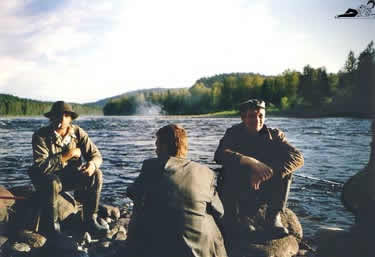 |
Fishers on the banks of the Biya |
The inhabitants of Altai consist of
– the descendants of all the peoples or tribes that inhabitated this
region before the arrival of the Russians, called Altaians (Altaitsy)
by 31% (data from 1999)
– the descendants of the Russians who came since the begining of
the 17th century, by 60% (among those are also descendants of people who
came from Ukraine, Belarus and other parts of Soviet Union since the 30-ies
of the 20th century)
– and the Kazakhs by 6%.
The Russians
started to come to Altai in the wake of the conquest of Siberia by Yermak
and his men. Altai became a refuge for people who wanted to escape from
serfdom or other forms of oppression, looking for a mythical land called
White Waters (Belovodye) where they would be free to practice their
beliefs and follow their aims. A part of those settlers again formed the
Old Believers who came after the split in the Russian Orthodox church,
the "Raskol" that took place between 1653 and 1656. One of the
most important communities of Old Believers in Russia which is still existing
to a certain extent, is in the Uimon Valley in southwestern Altai.
The Old Believers have been subject to persecution during the centuries
of Tsarist rule and again in Soviet times. This persecution started after
Altai became part of Russia, and it was the original Altai inhabitants
who helped them and provided shelter and hiding-places for them in these
harsh times. The situation somehow got under control with a decree of
Catherine The Great in 1792 that legalized their situation in turn for
a special annual tax that had to be paid in furs, the "Yasak".
With this decree they were acknowledged as citizens of Russia and inhabitants
of Altai, and what was very important for them, they were freed from recruitment
duties.
| The northwestern end of lake Teletskoye | 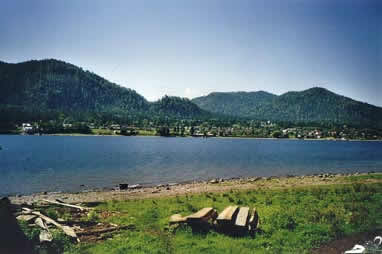 |
The traditional beliefs of the Altaians
are polytheistic. They believe in spirits of mountains, rivers, passes
and trees. They believed that the Earth was created out of the water,
in a kind of contest between two gods. They believed that the soul is
formed out of various rays coming from the earth, the sun and the moon.
In the 19th century many Altaians were forced to convert to Christianity
but the conversion was completely superficial and left little traces in
their spiritual world. There was also Buddhistic influence coming from
Mongolia and Tuva (East of the Altai) of which some elements were adopted
and incorporated into their nature religion.
Around the turn from the 19th to the 20th century a religious-political
movement emerged whose representatives strived for independence from Russia
and were persecuted by the Tsarist authorities. The "Burkhanism"
was a doctrine of salvation based on the appearance of a Messias called
Oirot who would come, wage war on Russia and unite the Altaians
in a country of their own. This Oirot was the mythical incarnation of
the founder of the Dzhungarian Khanate who was perceived by the Burkhanists
as the last representative of a state on their territory that they could
identify with.
Today most younger Altaians claim to be atheists. Together with many members
of the Russian population of Altai a great number of Altaians adore most
of all Vodka, or homemade alcohol, "samogon".
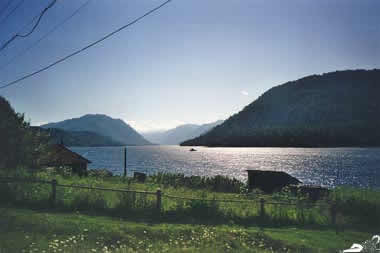 |
On the northern end of Lake Teletskoye |
To complete the spiritual geography of Altai one has to mention the beliefs and teachings of Nikolai Rerikh (1874-1947), a painter and philosopher who was especially attracted by the mountaineous parts of Central Asia and finally settled in Himalaya. He was interested in both the heathen beliefs of Altai, Mongolia, India as in the various forms of Buddhism being practiced in this region. He believed that some kind of Buddhist paradise called Shambala was to be found or should be founded in Altai. His writings today again have a lot of adherents in Russia some of whom travel to Altai and settle there, trying to discover Shambala.
| In a more centrally situated part of the lake | 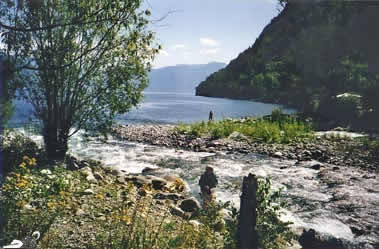 |
Lake Teletskoye
Lake Teletskoye is a narrow long mountain lake in the
form of an L. By depth it is the 5th or 6th in the world. It has a lot
of tributaries the biggest of which is the Chulyshman, and only one outlet,
the river Biya. The road from the north leads till Artybash and Yogach,
two villages at the northwest end of the lake. All other settlements on
it’s shore can only be reached across the lake, by boats in summer
and walking or riding across the ice in winter. In summer about once a
week a barge crosses the lake and supplies the settlements along the shore
and in the Chulyshman-valley with fuel and other goods.
People along the lake live mainly on hunting and fishing. The lake is
rich in fish and the surrounding mountains (the highest of which is Teletskii
with 2500 m) are the home of many eatable or fur-providing animals: Deers,
roes, elks and "marals", a central asian kind of deer, moreover
bears, sables, minks, and – very seldom – the "arkhar",
a kind of ibex, and the snow leopard.
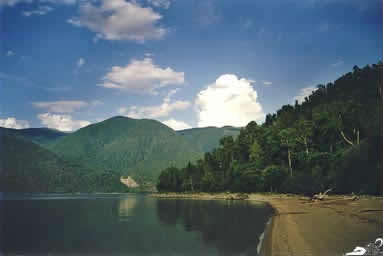 |
The south end of Lake Teletskoye In the distance a now idle quarry |
| South end of Lake Teletskoye | 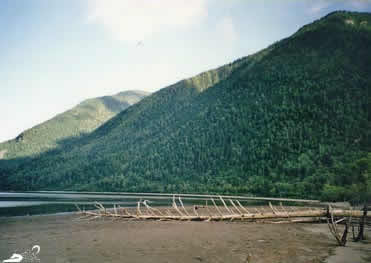 |
In summer here used to be a lot of tourism but as the
transport situation has deteriorated and food and accomodation have become
more expensive the inflow of tourists has shrunk considerably.
The lake serves as a kind of climate regulation, weaking the summer heat
and the winter’s frost. This has made it possible for a daring settler
to grow apples and rasperries in a place in the southern part of the lake,
thus contributing to the self-sufficency of the region.
At the bottom of the lake the water is so cold that no organisms can survive
there. The corpses of those who have drowned sink to the bottom and are
well preserved. I have been told by locals that during the civil war there
was a small battle on the shores of the lake, in winter, and afterwards
the corpses of those who had died in this battle, and of some horses,
too, were thrown into the lake and still can be seen at the bottom, and
what is more, in upright position, slowly moving in the water. So there
is a lot to see at the bottom of this lake!
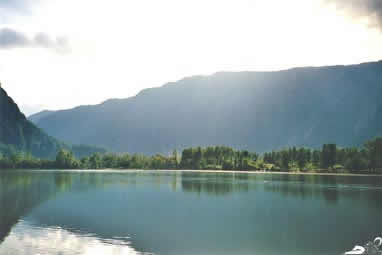 |
A bay in the south of the lake, where the Chulyshman flows into the lake. In the house on the shore lives a doctor responsible for the south part of Teletskoye. She attends her patients by boat. |
The Chulyshman valley
| The Chulyshman in about two hour’s distance from Lake Teletskoye | 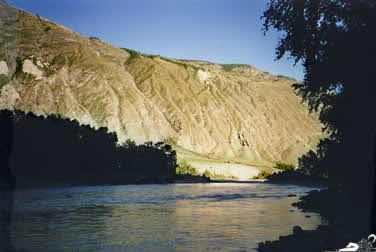 |
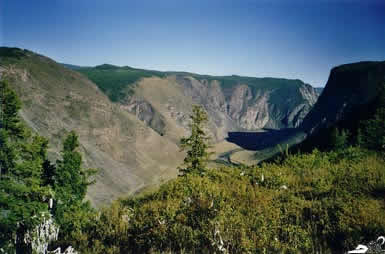 |
Sight from the Katu-Yaryk pass into the Chulyshman-valley |
|
The heights of the Katu-Yaryk pass. In the foreground
there are paper stripes attached to the twigs of the tree as a thanksgiving
to the spirits of this place who facilitated reaching the height
without accident
|
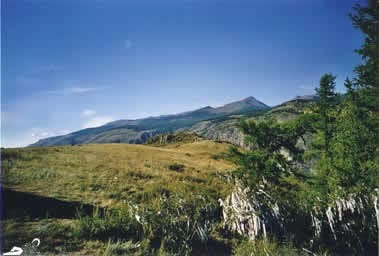 |